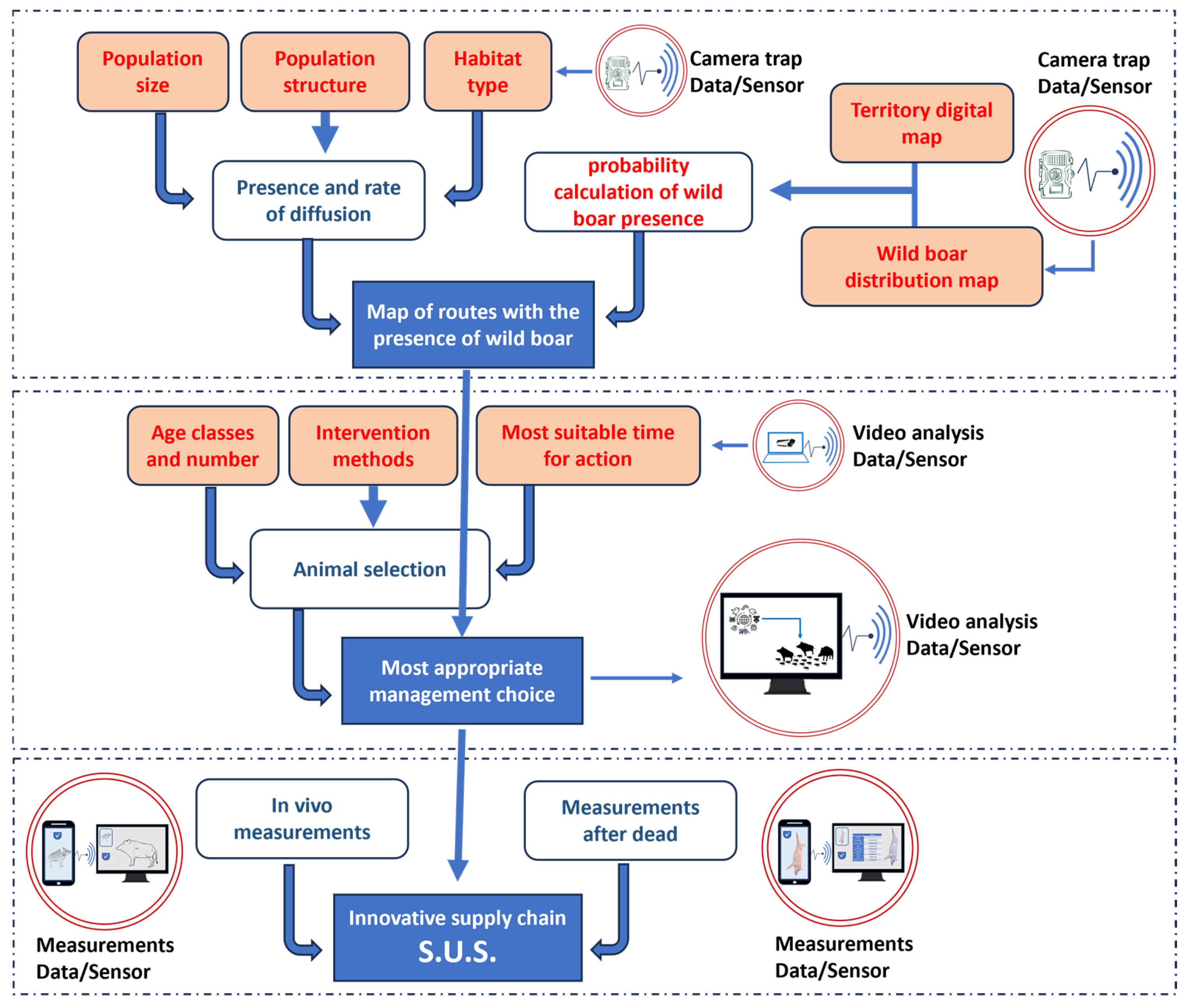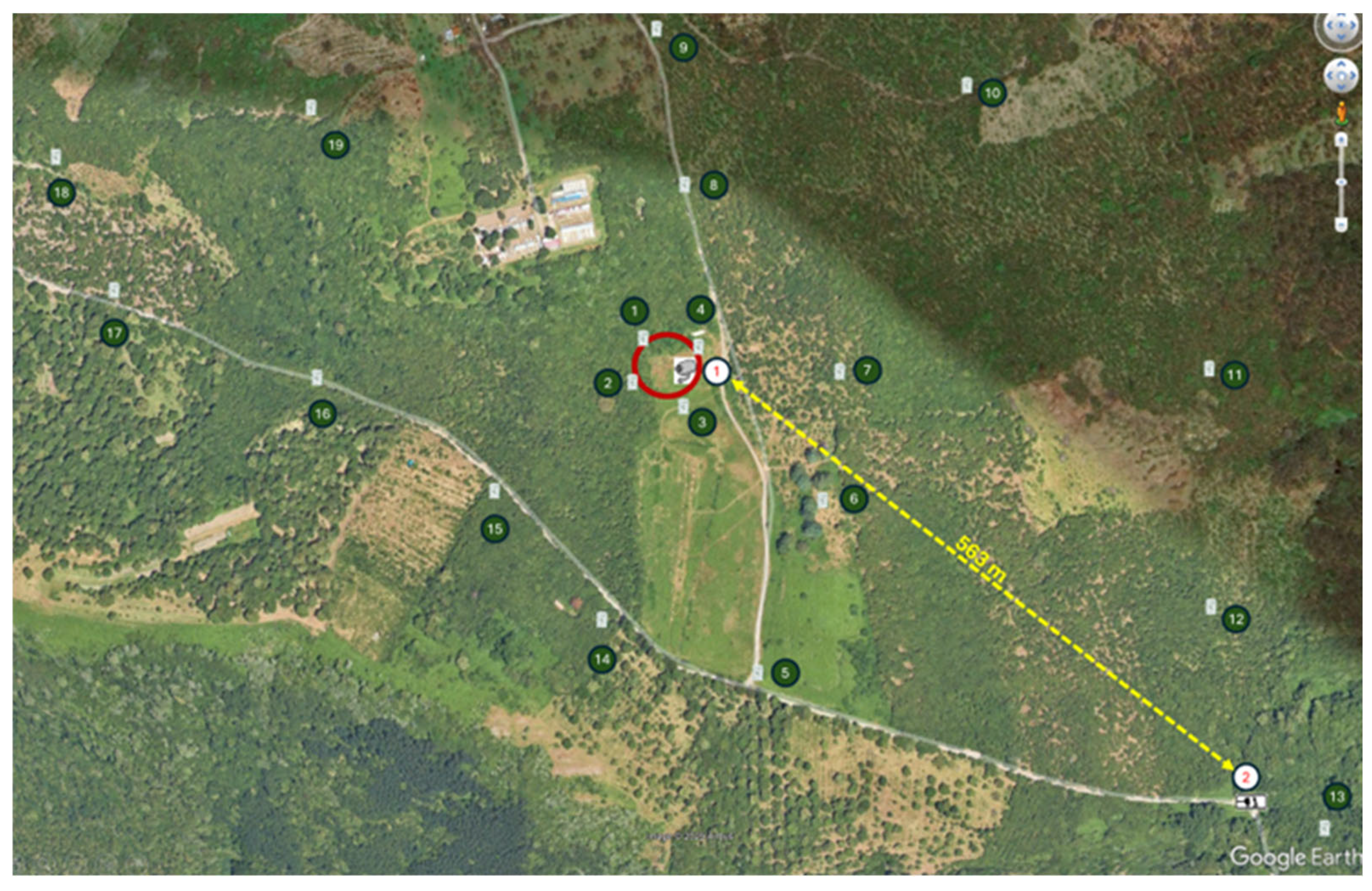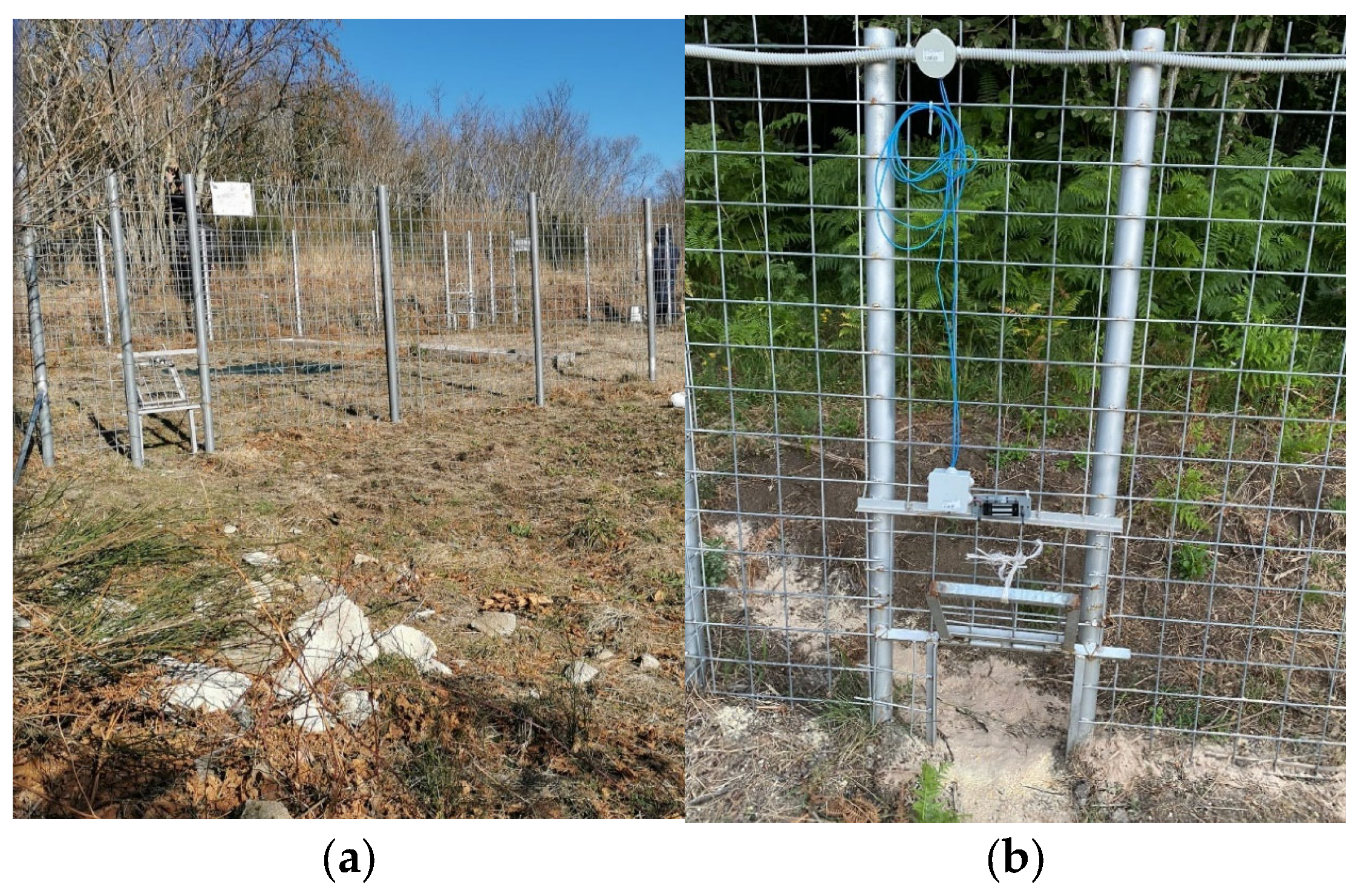Wild Boars’ Selective Capture with IoT and Electronic Devices Solutions for Innovative, Sustainable and Ethical Management
Abstract
1. Introduction
2. Materials and Methods
2.1. Experimental Design and Project Phases
- A smart infrared thermal camera capable of detecting temperature variations and monitoring defined perimeters, with real-time analysis of anomalies and movements. This system, installed on one of the poles on the perimeter of the capture cage, allowed the detection of the type of animals standing inside the cage. The counting of wild boars and the definition of their age classes was carried out using the GitHub algorithm—Ultralytics YOLO8 trained to recognize the morphological characteristics of wild boars (detection, object tracking, image classification). In the case of wild boars belonging to the right age class (sub-adults), the electronic processing unit allowed operators to activate the closing of the entrance doors to, subsequently, access the cage with the appropriate equipment necessary for the correct containment of the animals of interest. Conversely, in the case of the presence of wild boars of a different age class and/or of animals of other species, no action was performed [22,23,24,25,26,27].
- An electromagnetic lock is installed on each door to keep it normally open. The system consists of an electromagnet mounted on the door frame and a metal plate connected to the door via a cord. When powered, the electromagnet generates a strong magnetic field that holds the metal plate in place, keeping the cord taut and the door open. In the event of a power outage, the magnetic field dissipates, releasing the metal plate and the cord simultaneously. This mechanism ensures the door closes quickly and securely.
- Remote control of door locking thanks to LoRa Ping-Pong communication and end-to-end encryption (E2EE). The communication system consists of: (1) a remote device (telecommand), i.e., a portable LoRa controller, with a button to send commands, and (2) the electronic logic unit that controls the electromagnetic locks. Communication between the remote control and the logic unit uses AES-128 encryption to ensure security (E2EE). Each message sent is encrypted and includes a unique sequence number and timestamp to prevent replay attacks. When the user wants to close the doors, he presses the button on the LoRa remote control to start the procedure. The remote control then sends an encrypted Ping message containing the “ALERT” command, a sequence number and a MAC (Message Authentication Code) to ensure integrity (payload: {“command”: “ALERT”, “sequence”: 12345, “MAC”: “checksum”}). The logic unit receives the message, decrypts it using the shared AES key and verifies the sequence number and the MAC. If everything is valid, the STM32L072CZ microcontroller switches to the “ALERT” state and sends a Pong as a response, confirming the reception of the initial command ({“response”: “PONG”, “sequence”: 12345, “MAC”: “checksum”}). On the LoRa remote control, the lighting of a Yellow LED confirms to the user the correct reception of the Pong and the “ALERT” state of the logic unit, which is ready to receive the confirmation of closing the doors. When the button is pressed, the remote control sends a second encrypted message with the final command “RELAY_ON”, a new sequence number and the MAC (payload: {“command”: “RELEASE_ON”, “sequence”: 12346, “MAC”: “checksum”}). The logical unit receives the message, decrypts it, verifies the sequence number and the MAC and, if everything is valid, executes the command. The STM32L072CZ microcontroller sends a signal to the GPIO to switch the relay to the open (NO) state. This cuts off the power to the electromagnetic locks, bringing the magnetic field to zero. The metal plates are released, causing the doors to close quickly and safely. In practice, the system offers numerous advantages, including a high level of security guaranteed by AES-128 encryption, which prevents unauthorized access and ensures the integrity of the transmitted data. The double confirmation required to execute the command minimizes the risk of human errors or accidental activations, increasing the reliability of the system. Furthermore, LoRa communication enables long-range remote control with low power consumption, making the system highly efficient. The immediate feedback provided to the user ensures that the command has been correctly received and understood by the logic unit. These features make the system ideal for critical applications, such as managing cage doors, where closure at an inopportune moment could compromise the entire operation.
- Using a wireless Wi-Fi bridge, the infrared camera transmits real-time images of the inside of the cage to a remote station, making it an ideal solution for monitoring areas without telephone or Internet coverage and allowing specialized operators to intervene promptly when necessary [20]. In this specific case, the effective distance was 563 m in a straight line, with obstacles such as tall trees that could attenuate the signal (Figure 2). To ensure the connection, only two directional antennas were used, one for transmission and one for reception, without any intermediate repeaters. Figure 2 also indicates the locations of the devices. Point 1 marks the position of the trap, while Point 2 corresponds to the remote receiving station. Despite environmental challenges, the system maintained a stable and effective transmission.
- Autonomous power supply: the cage was equipped with an autonomous power supply system, which makes it possible to operate in remote areas without access to electricity networks. In particular, an isolated system was created with a solar system sized to power the three 12 V electromagnetic locks 24 h a day, the infrared camera with one side of the Wi-Fi bridge, and the door management logic unit. The overall consumption of the system, estimated at around 1.5 A (equal to 36 Ah per day), required the installation of a 72 Ah lead-acid battery (with a Depth of Discharge of 50%). To ensure efficient charging, a solar panel with a nominal power of 120 W was chosen, capable of supplying a current of around 7.2 A in the 5 h of useful sunshine per day, taking into account climatic variations. The system was completed with a 10 A charge regulator, compatible with the 12 V circuit, to manage current peaks and optimize battery charging. This sizing has ensured a stable and continuous operation of the system, even under conditions of intense use and environmental variability.
2.2. Selective Trap Cage System Features
- Schematic view of the selective trap cage:
- Detail of the selective overhead door:
- Infrared camera with intelligent features:
- IoT electronic unit for overhead door closure:
2.3. Statistical Analysis
3. Results
4. Discussion
5. Conclusions
6. Patents
Author Contributions
Funding
Institutional Review Board Statement
Informed Consent Statement
Data Availability Statement
Acknowledgments
Conflicts of Interest
References
- Boronyak, L.; Jacobs, B.; Wallach, A.; McManus, J.; Stone, S.; Stevenson, S.; Smuts, B.; Zaranek, H. Pathways towards coexistence with large carnivores in production systems. Agric. Hum. Values 2022, 39, 47–64. [Google Scholar] [CrossRef]
- Chapron, G.; Kaczensky, P.; Linnell, J.D.C.; von Arx, M.; Huber, D.; Andrén, H.; López-Bao, J.V.; Adamec, M.; Álvares, F.; Anders, O.; et al. Recovery of large carnivores in Europe’s modern human-dominated landscapes. Science 2014, 346, 1517–1519. [Google Scholar]
- Piscopo, N.; Gentile, L.; Scioli, E.; Alberti, J.P.; Esposito, L. Management models applied to the human-wolf conflict in agroforestry-pastoral territories of two Italian protected areas and one Spanish game area. Animals 2021, 11, 1141. [Google Scholar] [CrossRef]
- Amici, A.; Serrani, F.; Rossi, C.M.; Primi, R. Increase in crop damage caused by wild boar (Sus scrofa L.): The “refuge effect”. Agron. Sustain. Dev. 2012, 32, 683–692. [Google Scholar] [CrossRef]
- Laznik, Ž.; Trdan, S. Evaluation of different soil parameters and wild boar (Sus scrofa [L.]) grassland damage. Ital. J. Anim. Sci. 2014, 13, 759–765. [Google Scholar] [CrossRef]
- Primi, R.; Pelorosso, R.; Ripa, M.N.; Amici, A. A statistical GIS based analysis of wild boar (Sus scrofa) traffic collisions in a Mediterranean area. Ital. J. Anim. Sci. 2009, 8, 649–651. [Google Scholar] [CrossRef]
- Kruuse, M.; Enno, S.E.; Oja, T. Temporal patterns of wild boar-vehicle collisions in Estonia, at the northern limit of its range. Eur. J. Wildl. Res. 2016, 62, 787–791. [Google Scholar] [CrossRef]
- Castillo-Contreras, R.; Mentaberre, G.; Fernandez Aguilar, X.; Conejero, C.; Colom-Cadena, A.; Ráez-Bravo, A.; González-Crespo, C.; Espunyes, J.; Lavín, S.; López-Olvera, J.R. Wild boar in the city: Phenotypic responses to urbanisation. Sci. Total Environ. 2021, 773, 145593. [Google Scholar] [CrossRef]
- Saez-Royuela, C.; Telleriia, J.L. The increased population of the Wild Boar (Sus scrofa L.). Eur. Mammal. Rev. 1986, 16, 97–101. [Google Scholar] [CrossRef]
- Massei, G.; Kindberg, J.; Licoppe, A.; Gačić, D.; Šprem, N.; Kamler, J.; Baubet, E.; Hohmann, U.; Monaco, A.; Ozoliņš, J.; et al. Wild boar populations up, numbers of hunters down? A review of trends and implications for Europe. Pest Manag. Sci. 2014, 71, 492–500. [Google Scholar] [CrossRef]
- iNaturalist. Available online: https://www.inaturalist.org/taxa/42134-Sus-scrofa (accessed on 14 January 2025).
- Lowe, S.; Browne, M.; Boudjelas, S.; De Poorter, M. 100 of the World’s Worst Invasive Alien Species A selection from the Global Invasive Species Database; First Published as Special Lift-Out in Aliens 12; The Invasive Species Specialist Group (ISSG), a Specialist Group of the Species Survival Commission (SSC) of the World Conservation Union (IUCN): Gland, Switzerland, 2000; p. 12. [Google Scholar]
- Apollonio, M.; Randi, E.; Toso, S. The systematics of the wild boar (Sus scrofa L.) in Italy. Boll. Zool. 1988, 3, 213–221. [Google Scholar] [CrossRef]
- Gallo Orsi, U.; Macchi, E.; Perrone, A.; Durio, P. Biometric data and growth rates of a wild boar population living in the Italian Alps. Ibex J. Mt. Ecol. 1995, 3, 60–63. [Google Scholar]
- Scillitani, L.; Monaco, A.; Toso, S. Do intensive drive hunts affect wild boar (Sus scrofa) spatial behaviour in Italy? Some evidences and management implications. Eur. J. Wildl. Res. 2010, 56, 307–318. [Google Scholar] [CrossRef]
- Marsico, G.; Rasulo, A.; Dimatteo, S.; Tarricone, S.; Pinto, F.; Ragni, M. Pig, F1 (wild boar × pig) and wild boar meat quality. Ital. J. Anim. Sci. 2007, 6 (Suppl. S1), 701–703. [Google Scholar] [CrossRef]
- Schleimer, A.; Richart, L.; Drygala, F.; Casabianca, F.; Maestrini, O.; Weigand, H.; Schwartz, C.; Mittelbronn, M.; Frantz, A.C. Introgressive hybridisation between domestic pigs (Sus scrofa domesticus) and endemic Corsican wild boars (S. s. meridionalis): Effects of humanmediated interventions. Heredity 2022, 128, 279–290. [Google Scholar] [CrossRef]
- Pedone, P.; Mattioli, S.; Mattioli, L. Body size and growth patterns in wild boars of Tuscany, Central Italy. Ibex J. Mt. Ecol. 1995, 3, 66–68. [Google Scholar]
- Bouwman, I.; Schleyer, C.; Primmer, E.; Winkler, K.J.; Berry, P.; Young, J.; Carmen, E.; Špulerová, J.; Bezák, P.; Preda, E.; et al. Adoption of the ecosystem services concept in EU policies. Ecosyst. Serv. 2018, 29, 213–222. [Google Scholar] [CrossRef]
- Smith, A.; Pearson, L. Advancements in telemetry for wildlife tracking and management. Ecol. Appl. 2018, 28, 1245–1260. [Google Scholar]
- Johnson, M.; Thornton, D. Remote monitoring systems for wildlife traps: Improving animal welfare and efficiency in population management. Anim. Welf. J. 2019, 28, 123–130. [Google Scholar]
- Muller, Z.; Green, J. Integration of IoT technologies in wildlife management: Enhancements and applications. J. Precis. Livest. Farming 2020, 22, 45–60. [Google Scholar]
- Geisser, H.; Reyer, H.U. Efficacy of hunting, feeding, and fencing to reduce crop damage by wild boars. J. Wildl. Manag. 2004, 68, 939–946. [Google Scholar]
- Esposito, L.; Tafuri, S.; Cocchia, N.; Fasanelli, R.; Piscopo, N.; Lamagna, B.; Eguren, V.; Amici, A.; Iorio, E.L.; Ciani, F. Assessment of living conditions in wild boars by analysis of oxidative stress markers. J. Appl. Anim. Welf. Sci. 2021, 24, 64–71. [Google Scholar] [CrossRef]
- EFSA Report of the Networks on Animal Welfare 2022. Available online: https://www.efsa.europa.eu/en/supporting/pub/en-7764 (accessed on 14 January 2025).
- Piscopo, N.; Costanzo, M.; Gelzo, M.; Sacchettino, L.; Vitiello, C.; Balestrieri, A.; Napolitano, F.; Esposito, L. Effect of the sarcoptic mange upon metabolome profiling in wild boars. Res. Vet. Sci. 2025, 183, 105505. [Google Scholar] [CrossRef]
- Piscopo, N.; Tamburis, O.; Bonavolontà, F.; Verde, M.T.; Manno, M.; Mancusi, M.; Esposito, L. Assessing wild boar presence and activity in a monitoring specific area of Campania region using camera traps. Acta IMEKO 2023, 12, 1–5. [Google Scholar] [CrossRef]
- Esposito, L.; Viola, P.; Di Paolo, M.; Merino Goyenechea, L.J.; Marrone, R.; Altieri, D.; Primi, R.; Piscopo, N. The wild boar as an ecosystem service: Moving steps towards biodiversity engineering. In Proceedings of the 2nd Edition IEEE International Conference on Metrology for eXtended Reality, Artificial Intelligence and Neural Engineering, MetroXRAINE 2023, Milano, Italy, 25–27 October 2023; pp. 893–898. [Google Scholar] [CrossRef]
- Angrisani, L.; Bonavolontà, F.; d’Alessandro, G.; D’Arco, M. Inductive power transmission for wireless sensor networks supply. In Proceedings of the IEEE Workshop on Environmental, Energy, and Structural Monitoring Systems Proceedings, Naples, Italy, 17–18 September 2014. [Google Scholar] [CrossRef]
- Bonavolontà, F.; D’Arco, M.; Liccardo, A.; Tamburis, O. Remote laboratory design and implementation as a measurement and automation experiential learning opportunity. IEEE Instrum. Meas. Mag. 2019, 22, 62–67. [Google Scholar] [CrossRef]
- Liccardo, A.; Bonavolontà, F.; Balato, M.; Petrarca, C. Lora-Based Smart Sensor for PD Detection in Underground Electrical Substations. In Proceedings of the IEEE Transactions on Instrumentation and Measurement, Seoul, Republic of Korea, 16–20 May 2022. Art no. 3521013. [Google Scholar] [CrossRef]
- Liccardo, A.; Bonavolontà, F.; Romano, I.; Schiano Lo Moriello, R. Optimization and Performance Assessment of a Logic Selectivity Solution Based on LoRa Communication. Energies 2021, 14, 7359. [Google Scholar] [CrossRef]
- Angrisani, L.; Bonavolontà, F.; Liccardo, A.; Schiano Lo Moriello, R. On the Use of LoRa Technology for Logic Selectivity in MV Distribution Networks. Energies 2018, 11, 3079. [Google Scholar] [CrossRef]
- Angrisani, L.; Bonavolontà, F.; Dassi, C.; Liccardo, A.; Schiano Lo Moriello, R.; Tocchi, A. On the suitability of compressive sampling for lora signals classification. Int. Rev. Electr. Eng. 2020, 15, 187–198. [Google Scholar] [CrossRef]
- Ferrara, B. La Determinazione Dell’età Negli Animali; Edizioni Scientifiche Italiane: Napoli, Italy, 1965; pp. 172–191. [Google Scholar]
- Amato, A.; Amato, F.; Angrisani, L.; Barolli, L.; Bonavolontà, F.; Neglia, G.; Tamburis, O. Artificial intelligence-based early prediction techniques in agri-tech domain. In Proceedings of Advances in Intelligent Networking and Collaborative Systems: The 13th International Conference on Intelligent Networking and Collaborative Systems (INCoS-2021) 13; Springer International Publishing: Berlin/Heidelberg, Germany, 2022; pp. 42–48. [Google Scholar] [CrossRef]
- Sales, J.; Kotrba, R. Meat from wild boar (Sus scrofa L.): A review. Meat Sci. 2013, 94, 187–201. [Google Scholar] [CrossRef]









| Group Age (Months) | G1 1–6 | G2 7–12 | G3 12–24 | G4 >24 | Total |
|---|---|---|---|---|---|
| CT n. | 244 | 175 | 105 | 58 | 582 |
| CT % | 42 Aa | 30 b | 18 cB | 10 B | |
| IoT n. | 198 | 138 | 79 | 46 | 461 |
| IoT % | 43 Aa | 30 b | 17 cB | 10 B |
| Year | 2019 | 2020 | 2021 | 2022 | 2023 | Total |
|---|---|---|---|---|---|---|
| G1 | 34 | 29 | 48 | 36 | 51 | 198 |
| G2 | 15 | 36 | 41 | 11 | 35 | 138 |
| G3 | 13 | 15 | 15 | 17 | 19 | 79 |
| G4 | 8 | 11 | 5 | 9 | 13 | 46 |
| Total | 70 | 91 | 109 | 73 | 118 | 461 |
Disclaimer/Publisher’s Note: The statements, opinions and data contained in all publications are solely those of the individual author(s) and contributor(s) and not of MDPI and/or the editor(s). MDPI and/or the editor(s) disclaim responsibility for any injury to people or property resulting from any ideas, methods, instructions or products referred to in the content. |
© 2025 by the authors. Licensee MDPI, Basel, Switzerland. This article is an open access article distributed under the terms and conditions of the Creative Commons Attribution (CC BY) license (https://creativecommons.org/licenses/by/4.0/).
Share and Cite
Verde, M.T.; Esposito, L.; Bonavolontà, F.; Tamburis, O.; Liccardo, A.; Piscopo, N. Wild Boars’ Selective Capture with IoT and Electronic Devices Solutions for Innovative, Sustainable and Ethical Management. Sensors 2025, 25, 2071. https://doi.org/10.3390/s25072071
Verde MT, Esposito L, Bonavolontà F, Tamburis O, Liccardo A, Piscopo N. Wild Boars’ Selective Capture with IoT and Electronic Devices Solutions for Innovative, Sustainable and Ethical Management. Sensors. 2025; 25(7):2071. https://doi.org/10.3390/s25072071
Chicago/Turabian StyleVerde, Maria Teresa, Luigi Esposito, Francesco Bonavolontà, Oscar Tamburis, Annalisa Liccardo, and Nadia Piscopo. 2025. "Wild Boars’ Selective Capture with IoT and Electronic Devices Solutions for Innovative, Sustainable and Ethical Management" Sensors 25, no. 7: 2071. https://doi.org/10.3390/s25072071
APA StyleVerde, M. T., Esposito, L., Bonavolontà, F., Tamburis, O., Liccardo, A., & Piscopo, N. (2025). Wild Boars’ Selective Capture with IoT and Electronic Devices Solutions for Innovative, Sustainable and Ethical Management. Sensors, 25(7), 2071. https://doi.org/10.3390/s25072071











